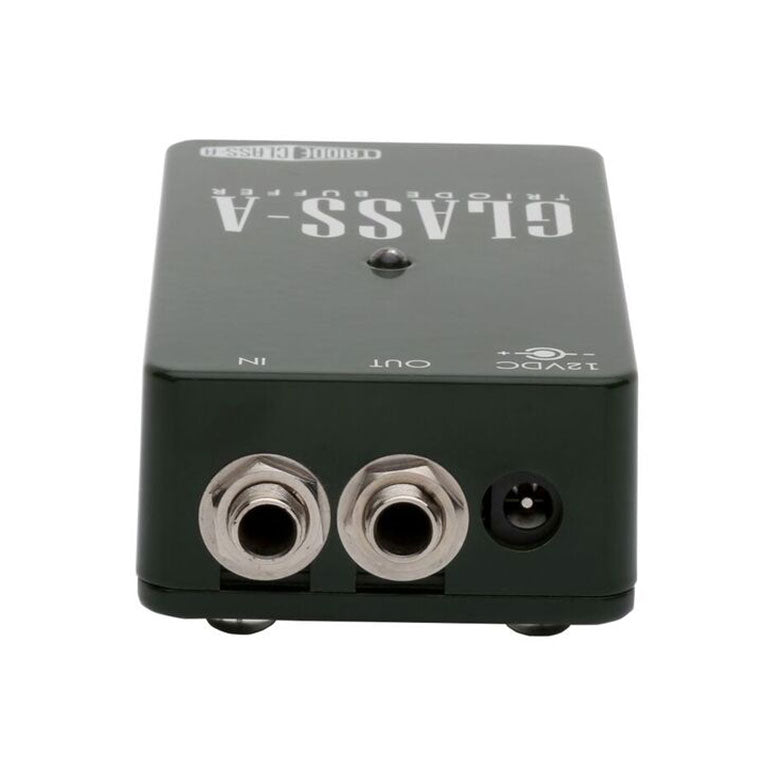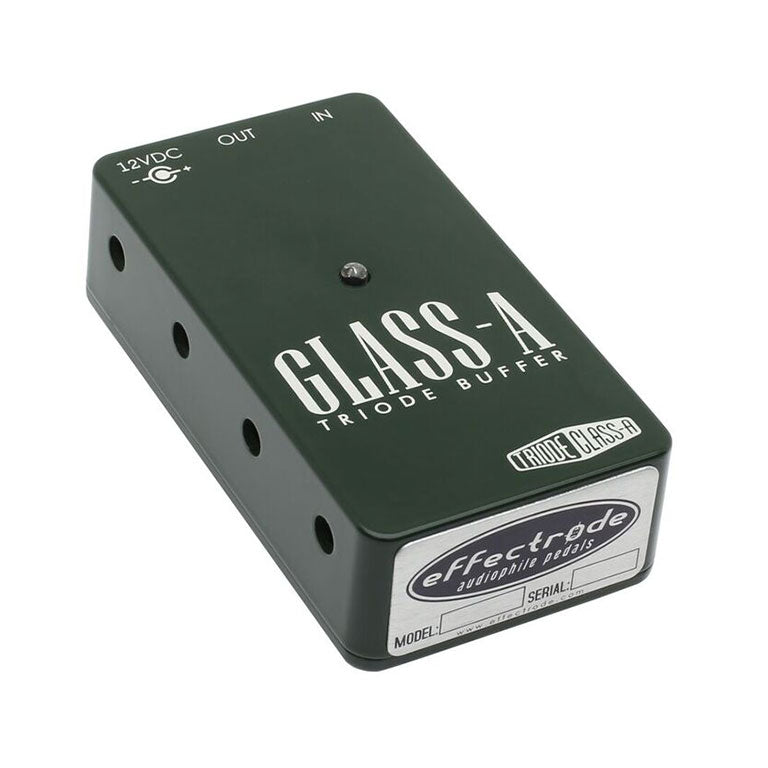Effectrode
Glass-A
Glass-A
FREE 2Day Shipping
FREE 2Day Shipping
USA Free 2 Day Shipping
(Next day in New England)
Canada NOW FREE!
Worldwide 30USD Flat Rate*(Wherever you are)
Flat Rate means no additional charge for more than one pedal.
No Hassle Returns
No Hassle Returns
Just let us know within 30 days from arrival.
If there's a malfunction, shipping's on us.
Couldn't load pickup availability
Triode Buffer
Effectrode's Glass-A model GL-1A triode buffer is specially designed to do just one thing very , very well – buffer the output signal from a musical instrument fitted with high impedance pickups or piezo transducer to prevent 'loading' which dulls and degrades the instrument's tone.
High voltage tube circuitry coupled with audiophile passive components makes the Glass-A a sonic dream! Its frequency response is flat from 5Hz to over 100KHz with a shallow roll-off to maintain low phase distortion. The wide linear region of a tube operating at 300V means this buffer can handle signal levels of over 50V P-P and its parallel cathode follower circuitry ensures whisper quiet operation and superb line-drive capability. Effectrode's Glass-A will effortlessly handle active 5-string bass guitars, NS Stick and even ‘difficult’ instruments with fast transients such as lutes, harpsichords and hammered dulcimers to reveal more detail and improve the depth and clarity and of these instruments.
What is a Buffer? Technically a buffer is a unity gain (0dB) amplifier circuit with a high input impedance and low output impedance. In practice buffer pedals are used to prevent high frequency 'roll-off' and preserve the brightness of a guitar when connecting it to long cables or effects pedals with lower impedance input stages.
Where to Use a Buffer? Ideally a passive guitar pickup should 'see' a 1MΩ resistive load with a capacitance of just a few tens of picofarads in parallel with it. This load is the input impedance of a typical vintage Fender tube amp. If you're using a good quality instrument cable (such as Evidence Audio or Death Valley Cable Company) of less than 15’ between your guitar and tube amp then you almost certainly do not require a buffer – there will be no significant degradation of tone. However, if the load resistance connected to your guitar pickup is lower than this or the capacitance creeps up into the hundreds of picofarads range then attenuation of higher frequencies will occur. Subjectively this causes loss of brightness or 'sparkle' making the guitar tone dull and lifeless. The graph on the next page compares the effects of 100ρF and 625ρF capacitive loads on a typical single coil pickup.
Guitar cable capacitance can present itself as an adverse load if the cable is very long or poor quality. This is especially a problem with cheaper cables with plastic molded jack plugs, which often exhibit high capacitance. This becomes an even greater problem with longer cables. Even the highest quality cable and connector has some degree of capacitance, however placing a buffer between the guitar and cable will negate its effect to restore brightness significantly improving clarity and definition.
As well as cable loading there are effect pedals that present an adverse load to your guitar. Examples include the Binson Echorec, which – although a beautiful sounding delay machine – has a very low input impedance of 47KΩ. Another vintage effect with low input impedance is the Uni-Vibe at 68KΩ.
There are also some older effect pedals that keep their input circuitry connected, even when the bypass switch is pressed, and using several of these pedals in series will result in a cumulative lowering of input impedance. With these kinds of effect pedals, again placing the buffer before them will prevent loading and revitalise tone.
Another problem with certain effect pedals is that they have poor output drive capability or to put it another way they have a high impedance output buffer stage. Even when the pedal is engaged the buffer circuitry cannot adequately drive the load that cables or other pedals present. An example of this is a passive volume pedal, with an output impedance of several hundred KΩ. A buffer should be used after these types of pedals to prevent tone loss.
A buffer can also help with certain effects that are prone to self-oscillation. These include some wahs, fuzzes and the Effectrode Phaseomatic. If these pedals see a high input impedance or open circuit they begin to 'chirp' or squeal uncontrollably generating sounds independently of the guitar input signal. In some cases this might be desirable, for instance if you're trying to create 1950s sci-fi effects with the Phaseomatic, however if you're in a live situation you, your audience and especially your sound engineer won’t appreciate hearing a wah pedal squealing uncontrollably. Placing a buffer before these problem pedals will ensure they always see a low impedance and prevent selfoscillation.








